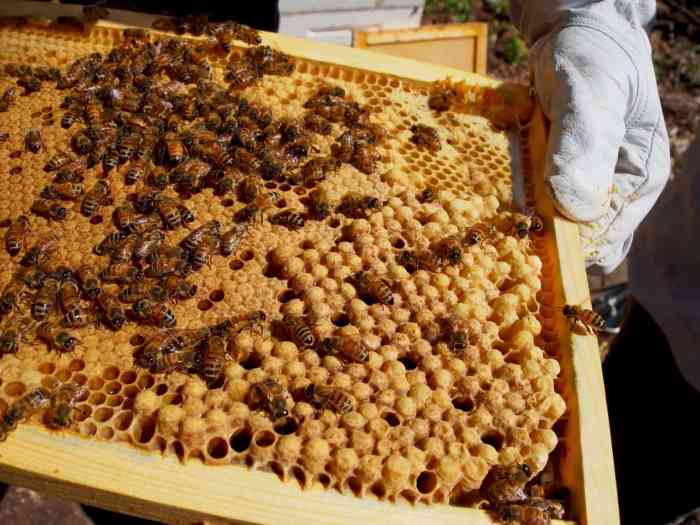Unveiling the secrets of how to find beehives is a fascinating journey that unveils the intricate world of these buzzing pollinators. From understanding their hive structure to employing advanced techniques, this guide provides a comprehensive roadmap for locating honey-producing colonies.
Delving into the anatomy of a beehive, we discover the queen, worker bees, and drones, each playing a vital role in the hive’s organization. Different hive types, such as Langstroth and top-bar hives, are explored, along with the typical behavior and swarming patterns of bees.
Understanding Beehive Structure and Behavior

A beehive is a fascinating and complex structure that houses a thriving colony of bees. Understanding the anatomy and organization of a beehive is crucial for successful beekeeping and conservation efforts.
Queen Bee
The queen bee is the heart of the hive. She is responsible for laying eggs and maintaining the colony’s population. The queen is larger than other bees and has a distinctive, elongated abdomen.
Worker Bees
Worker bees are the backbone of the hive. They are responsible for a wide range of tasks, including foraging for food, building and maintaining the hive, and caring for the brood.
Drones
Drones are the only male bees in the hive. Their sole purpose is to mate with the queen. Drones are larger than worker bees but have no stinger and do not participate in any hive duties.
Hive Types
There are various types of beehives, each with its own advantages and disadvantages. Common types include:
- Langstroth hives: The most popular type of hive, consisting of a series of removable frames.
- Top-bar hives: A simpler and more natural hive design, with a removable top bar for inspection.
Bee Behavior
Bees exhibit distinct behaviors that are essential for the survival and prosperity of the hive. These include:
- Swarming: When a hive becomes overcrowded, a group of bees may leave to establish a new colony.
- Foraging: Worker bees spend a significant portion of their time foraging for nectar, pollen, and water.
- Communication: Bees use a variety of dances and vocalizations to communicate with each other.
Identifying Potential Beehive Locations

Locating potential beehive sites is crucial for beekeepers and researchers. Here are some tips:
Bee Activity
Observing bee activity can provide valuable clues about the presence of a hive. Look for bees flying in and out of potential nesting sites, especially during the morning and evening.
Honeycombs
Honeycombs are the hexagonal structures where bees store honey and brood. Visible honeycombs on trees, rocks, or other surfaces may indicate the presence of a nearby hive.
Landmarks
Bees often nest near water sources, such as rivers or ponds. Trees with cavities or crevices can also provide suitable nesting sites. Landmarks can help narrow down search areas.
Sunlight and Shelter
Bees prefer nesting sites with ample sunlight for warmth and protection from the elements. Consider factors such as the orientation of the site and the presence of trees or other structures that provide shelter.
Access to Forage
Bees require access to a variety of flowers and other sources of forage. Look for areas with abundant wildflowers, gardens, or other bee-friendly plants.
Visual Inspection and Observation Techniques

Approaching and observing a beehive requires caution and the use of appropriate techniques:
Visual Cues
Visual cues that may indicate the presence of a beehive include:
- Bee activity: Observe the number and behavior of bees entering and leaving a potential nesting site.
- Honeycomb: Look for visible honeycombs or wax cappings, which are signs of an active hive.
- Entrance: Locate the entrance to the hive, which may be a small hole or crack in a tree or structure.
Safe Observation, How to find beehives
To safely approach and observe a beehive:
- Wear protective clothing: Cover exposed skin and wear a beekeeper’s veil or suit.
- Avoid sudden movements: Approach the hive slowly and calmly, avoiding any jarring actions.
- Maintain a safe distance: Observe the hive from a distance of at least 10 feet to minimize disturbance.
Binoculars and Telephoto Lenses
Binoculars or telephoto lenses can be used to observe bees from a safe distance. This allows for detailed observation of bee behavior and hive activity.
Using Sound and Scent to Locate Beehives
Sound and scent can be valuable tools for locating beehives:
Sound
Bees produce a distinct humming sound that can be detected using a stethoscope or other listening device. Place the device against a potential nesting site to listen for the humming.
Scent
Honey and beeswax have a characteristic scent that can be detected by humans. Follow your nose to locate potential hives, but be aware that other insects or animals may also be attracted to the scent.
Limitations and Safety
Using sound and scent to locate beehives has limitations and safety considerations:
- Distance: Sound and scent may not be detectable from a significant distance.
- Accuracy: False positives may occur due to other insects or animals producing similar sounds or scents.
- Disturbance: Using sound or scent too close to the hive may disturb the bees.
Advanced Techniques for Beehive Detection: How To Find Beehives

Advanced technologies offer additional methods for locating beehives:
Thermal Imaging Cameras
Thermal imaging cameras can detect the heat signature of bees, making them useful for locating hives in hidden or inaccessible areas.
Drones and Aerial Devices
Drones or other aerial devices can be used to survey large areas for beehives. They can capture high-resolution images and videos to identify potential nesting sites.
Ethical Considerations
Using advanced technologies for beehive detection raises ethical considerations:
- Privacy: Drones and other aerial devices may invade the privacy of landowners or disturb sensitive habitats.
- Regulations: Some areas may have regulations or restrictions on the use of drones or thermal imaging for beehive detection.
Common Queries
Can I find beehives in urban areas?
Yes, beehives can be found in urban areas, often in parks, gardens, or even rooftops.
Is it safe to approach a beehive?
Approaching a beehive can be safe if done cautiously. Wear protective clothing, avoid sudden movements, and observe the bees’ behavior from a distance.
What time of year is best for finding beehives?
Spring and summer are the best times to find beehives, as bees are actively foraging and building their colonies.
